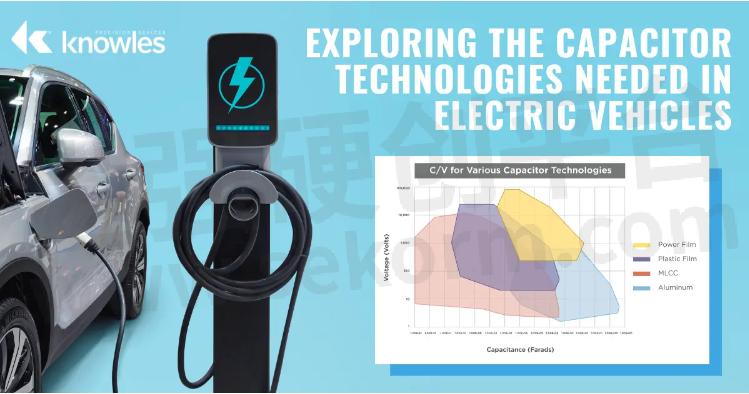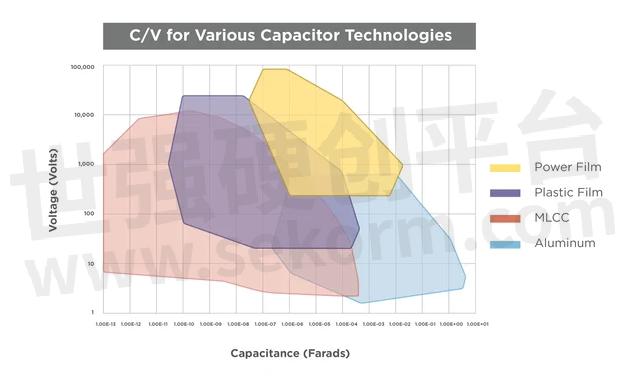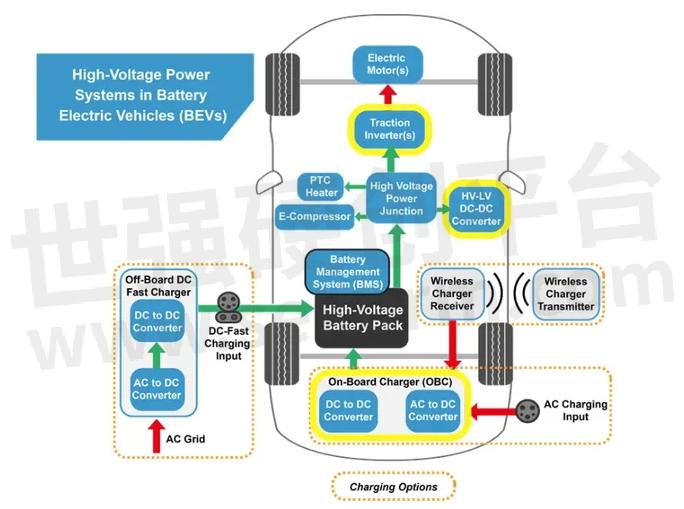Exploring the Capacitor Technologies Needed in Electric Vehicles

The electrical power systems in most modern technologies, like electric vehicles (EVs), are complex. In EVs specifically, power systems are responsible for performing many tasks such as converting AC to DC and DC to AC as well as managing changing power levels in DC/DC conversion. When performing these tasks, manipulating AC voltages and removing noise from DC voltage requires passive components such as capacitors, to perform many “jobs” inside the power system. But no single capacitor type can perform all these jobs since each one has different requirements for voltage, size, temperature, and reliability. Therefore, a variety of capacitor technologies, such as ceramic, film, and aluminum, are required to meet all these needs.

As a starting point to understanding what technology to use, let’s look at the graph in Figure 1 to see the capacitance and voltage ranges covered by each capacitor type In general, you can expect to see the following capacitance ranges:
Key Functional Components in Radar Systems
We can learn a lot about radar systems by looking at the functional components and what specific tasks they perform. In the diagram below, we treat each function as a separate block, even though these functions can be combined or divided across several circuits.
Multilayer ceramic capacitors (MLCCs) from under a picofarad to hundreds of microfarads
Film from under a nanofarad to tens of millifarads
Aluminum from under a microfarad to several farads

Figure 1: The capacitance and voltage ranges covered by common capacitor technologies.
As you can see, each technology’s range overlaps with the other, which means you need to truly understand the specific application and its voltage, size, temperature, and reliability requirements before you can select the best option. Let’s now look at some of the common applications where capacitors are required inside the EV, the different jobs capacitors must take on, and the capacitor technologies commonly used for those jobs.
The Many Roles Capacitors Play in EV Power Systems
Power systems within EVs must reliably handle large amounts of fluctuating power. While Figure 2 shows all the different functional blocks in an EV power system, we will focus specifically on the roles capacitors play in the following functions:
Traction inverter (DC to AC)
Onboard charger (AC to DC)
DC/DC converter

Figure 2: A diagram highlighting the different functional blocks in a high-voltage power system in an EV. The three functions we will discuss in this post are highlighted in yellow.
Traction Inverter
The function of an inverter is to convert DC power to AC. This function is commonly required in the traction inverter in an EV where battery DC is converted to AC for the motor. The major capacitor roles required here include the following (Figure 3):

Figure 3: A diagram of a traction inverter with the locations of the various capacitors called out.
On-Board Charger
An on-board charger takes AC power and converts it to DC to charge the battery. The major capacitor roles here include the following (Figure 4):
DC link capacitors
DC filtering capacitors
Snubber capacitors
AC filtering capacitors

Figure 4: A diagram of an on-board charger with the locations of the various capacitors called out.
DC/DC Converter
The DC/DC converter takes the high-voltage battery power and converts it to a lower voltage. The major capacitor roles here include the following (Figure 5):
DC link capacitors
DC filtering capacitors
Snubber capacitors
Resonant capacitors

Figure 5. A diagram of a DC-DC converter with the locations of the various capacitors called out.
So now you’re probably wondering, of the different capacitor technologies, which one is the best option for each of these jobs? As mentioned, the type of capacitor technology you will need depends on the specific voltage, size, temperature, and reliability requirements of the application, but there are some overall trends we are seeing:
Film and aluminum are typically used for DC link capacitors
Film and MLCCs are typically used for filtering capacitors
Film and MLCCs are typically used for resonant capacitors
Film and MLCCs are typically used for snubber capacitors
- +1 Like
- Add to Favorites
Recommend
- Empower Expands E-CAP Silicon Capacitor Portfolio by Using the Most Advanced Trench Capacitor Technology, making a Breakthroughs in Density and Performance
- What Is a Cylindrical Supercapacitor?
- What are Flying Capacitors?
- Advantages and Disadvantages of Electric Double Layer Capacitors
- Supercapacitor Maintenance Considerations
- How Does the Button Fara Capacitor Work?
- Button Supercapacitor Classification Methods and Precautions
- Key Features of Button Supercapacitors
This document is provided by Sekorm Platform for VIP exclusive service. The copyright is owned by Sekorm. Without authorization, any medias, websites or individual are not allowed to reprint. When authorizing the reprint, the link of www.sekorm.com must be indicated.












































































































































































































































































































































































































































































































































































































































































































































































































































